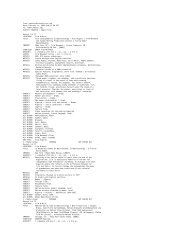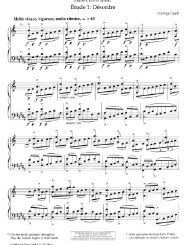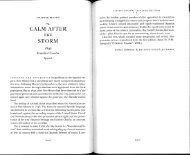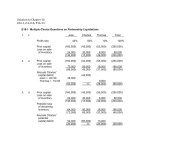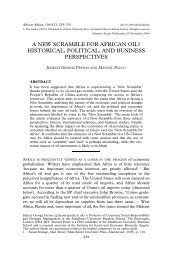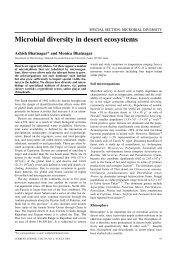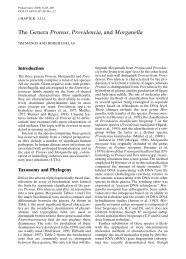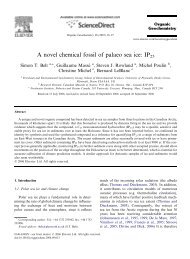Analysis by Key: Another Look at Modulation
Analysis by Key: Another Look at Modulation
Analysis by Key: Another Look at Modulation
Create successful ePaper yourself
Turn your PDF publications into a flip-book with our unique Google optimized e-Paper software.
CARI SCHACHTER<br />
11. David Beach, 'A Recurring P<strong>at</strong>tern in Mozart's Music', ffournal of Music Theory,<br />
Vol. 27, No. 1 (Spring 1983), pp. l -29.<br />
12. Heinrich Schenker, 'Die Kunst der Improvis<strong>at</strong>ion', in Das Meisterwerk in der<br />
Musik, Vol. 1, p. l 5. For Schenker, Bach's formul<strong>at</strong>ion was in keeping with his own<br />
conception of keys as prolonged 'scale steps of the tonality' (Tonarten als Stufen der<br />
Tonalit<strong>at</strong>), a conception revealed in many of the graphs of Das Meisterwerk. The<br />
Bach cit<strong>at</strong>ion is from Carl Philipp Emmanuel Bach, Essay on the True Art of Playing<br />
<strong>Key</strong>board Instruments, trans. and ed. William J. Mitchell (New York: Norton,<br />
1949), pp.440-5.<br />
13. Jean-Philippe Rameau, Tre<strong>at</strong>ise on Harmony, trans. Philip Gossett (New York:<br />
Dover, 1971), pp.267-9. In the original edition, Traite de l'harmonie reduite a ses<br />
principes n<strong>at</strong>urels (Paris: Ballard, 1722), reprinted in facsimile as Vol. 1 of Jean-<br />
Philippe Rameau, Complete Theoretical Writings, ed. Erwin R. Jacobi (American<br />
InstituteofMusicology, 1967),pp.248-51.<br />
14. Johann Philipp Kirnberger, The Art of Strict Musical Composition, trans. David<br />
Beach and Jurgen Thym (New Haven: Yale, 1982), pp.l21-37; the table with<br />
Roman numerals is on p. l 24. This public<strong>at</strong>ion includes Vol. I and Part I of Vol. II<br />
of Kirnberger's Die Kunst des reinen S<strong>at</strong>zes in der Musik, 2 vols (Berlin and<br />
Konigsberg, 1771-9; photographic facsimile bound in one volume, Hildesheim:<br />
Olms, 1968), pp.103-20. The table with Roman numerals is on p.106.<br />
15. Gustav Jenner, 3ohannes Brahms als Mensch, Lehrer und Kunstler: Studien und<br />
Erlebnisse (Marburg in Hessen: Elwert, 1905), p.38.<br />
16. H.K. Andrews, 'Modul<strong>at</strong>ion', in Grove's Dictionary of Music and Musicians, 5th<br />
edn, ed. Eric Blom (London: Macmillan, 1954), Vol. 5, p.807.<br />
17. Ibid., p.810.<br />
18. Schenker, Harmonielehre, pp.396-9; English transl<strong>at</strong>ion, pp.299-300. The English<br />
version transl<strong>at</strong>es 'Di<strong>at</strong>onie' as 'di<strong>at</strong>onic system' and 'Scheintonarten' as 'simul<strong>at</strong>ed<br />
keys'; the divergent transl<strong>at</strong>ions in my text conform to Oster's terminology in Free<br />
Composition.<br />
19. Ibid., pp.391-4 (German edition); pp.295-8 (English edition).<br />
20. Ibid ., p.397 (German edition); pp.299-300 (English edition).<br />
21. Tovey reads exactly the same key succession: see his A Companion to Beethoven's<br />
Pianoforte Son<strong>at</strong>as (London: Associ<strong>at</strong>ed Board, 1931), pp.36-7.<br />
22. See Arnold Schoenberg, Structural Functions of Harmony, rev. edn (New York:<br />
Norton, 1969), pp.20, 68 and 75. Incidentally, Schoenberg regards di<strong>at</strong>onic II in<br />
major (which he calls dorian) as belonging to the same class of regions as these E<br />
minor passages in C minor and as more distant from the tonic than, say, bIII in<br />
major. But are not both E minor passages far less normal than the toniciz<strong>at</strong>ion of II<br />
in Beethoven's First Symphony, I, bs 19-23, or any of the numerous arrivals on II<br />
after the double bar in Bach's suite movements (e.g., Fourth French Suite,<br />
Sarabande, bs 13-16)? Schoenberg's classific<strong>at</strong>ion of the distances from the tonic of<br />
the various regions sometimes seems counterintuitive and not in accordance with<br />
historical evidence, but I doubt th<strong>at</strong> any other system<strong>at</strong>ic account of 'distance'<br />
would be much of an improvement.<br />
23. Schenker, Free Composition, pp.ll-12. Of course the octave line would yield the<br />
316 MUSIC ANALYSIS 6: 3, 1987



